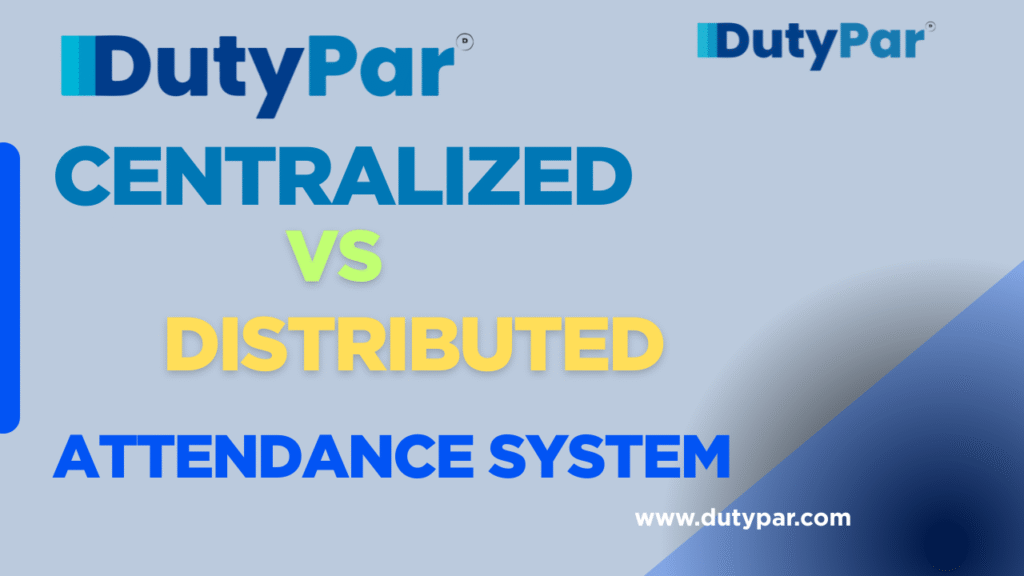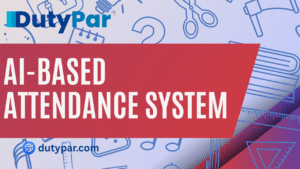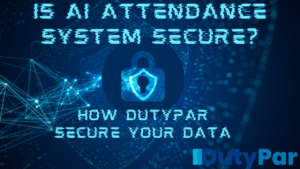
Table of contents
- Understanding Centralized and Distributed Attendance Systems
- Key Benefits of Each System
- When to Use Each System
- Table: Feature Comparison
- Data Security and Compliance
- Integration and Maintenance
- Cost Considerations
- User Experience and Training
- DutyPar: Simplifying Attendance Management
- Best Practices for Implementation
- Conclusion
In today’s fast-moving workplace environment, your decision to go with a Centralized or Distributed Attendance System affects how you track time. Having both options has its pros. You have to consider what option is best for you. A Centralized vs Distributed Attendance System comparison can help make that decision. This article will explore each system individually. We will examine each system’s strengths, weaknesses, and the best use cases for each. When you are finished, you’ll know which option fits your team best for tracking time.
Understanding Centralized and Distributed Attendance Systems
Understanding the differences between centrally controlled and distributed systems is necessary. Centralized systems are controlled by a single, central point, similar to a hub controlling the many activities of the spokes. For example, a school administrative office would oversee every classroom and teacher. Distributed systems can be thought of as a team of equals because they do not have a single point of control. Each component in the distributed system can act independently, but they all work together transparently, similar to computers connected to each other. This article will help you recognize the importance of centralized and distributed systems among their various applications and their implications for the design and management of effective systems.
Centralized Attendance System
In a centralized system, there is one main computer or server that performs all of the processing, data storage, and decision making. Everything essentially comes from one control center. A centralized system also controls and manages all of the resources and significant decisions for the whole system. In a centralized system, all resources, data, and functionality are managed and controlled from one area, via the designated system.
Distributed Attendance System
Different parts of a computer system can be found in a distributed system on different computers or devices that are connected together as a network. Each computer or device operates independently, but they come together to process information, retain data, or provide services.
Key Benefits of Each System
Choosing between a Centralized or Distributed Attendance System means weighing benefits. Let’s break them down:
- Data Control
- Centralized: Offers tight control from one hub.
- Distributed: Empowers local teams with autonomy.
- Reliability
- Centralized: Depends on a single server.
- Distributed: Remains up if one node fails.
- Performance
- Centralized: May slow down with heavy traffic.
- Distributed: Ensures fast local access.
- Maintenance
- Centralized: Eases updates from one spot.
- Distributed: Requires more effort to update all nodes.
When to Use Each System
A Centralized vs Distributed Attendance System choice depends on your structure:
- Small to Mid‑Size Companies:
A centralized system works well. It simplifies operations. You can manage attendance from one console. - Large Enterprises with Multiple Sites:
A distributed system excels. You avoid network lags. You lessen downtime for local teams. - Remote or Hybrid Teams:
A centralized system lets you standardize policies. You keep everyone on the same page. - High‑Security Environments:
A distributed system lets you isolate data. You limit access to sensitive sites.
Table: Feature Comparison
| Feature | Centralized System | Distributed System |
|---|---|---|
| Data Location | One main server | Multiple local servers |
| Network Dependency | High | Low |
| System Reliability | Single point of failure | High resilience |
| Maintenance | Easy updates | Complex synchronization |
| Scalability | Moderate | High |
| Real‑Time Local Access | Slower | Faster |
| Data Security | Centralized control | Local isolation |
| Cost | Lower setup cost | Higher initial cost |
Data Security and Compliance
When comparing a Centralized vs Distributed Attendance System regard to security; the centralized model will allow an organization to protect data centrally (data is managed from a single source). It is easy to put a strong firewall in place, and difficult to encrypt data from individual points in the network. if that single point of control is breached, all data will be at risk.
In a distributed model, data is dispersed. By dividing risk, you have less risk if a single node is broken into. However, you must manage to enforce the same security policies across all pilots. This will be difficult to accomplish with a small IT team.
Integration and Maintenance
Integration is still pivotal in any decision for or against a Centralized vs Distributed Attendance System. Centralized solutions are often easier to integrate HR or payroll software into. One connection; you are done.
Distributed solutions have many nodes, which are each separate connection. Updates aren’t necessarily consistent on each node. Keeping track of each node can require solid processes to keep them synced. If you have an IT team or strong managed-service partner, you will be fine.
Cost Considerations
Centralized vs Distributed Attendance System choice affects your budget:
- Centralized System Costs:
Lower hardware cost. Less networking gear. Minimal IT staffing. - Distributed System Costs:
More servers. Redundant network infrastructure. Higher staffing or service fees.
While distributed systems cost more upfront, they can lower indirect costs. For example, faster local access boosts productivity. Less downtime protects revenue.
User Experience and Training
Usability influences adoption. A Centralized vs. Distributed Attendance System must feel easy and straightforward to use. Centralized dashboards typically look the same for all users. You will be able to train staff only once.
In distributed systems, you may have additional training hurdles. Each team might see slightly different and another interface. You will need to create clear and concise guides for every team.
DutyPar: Simplifying Attendance Management
Read More: Attendance Management System with Face Recognition Technology
Now that you know the Centralized vs Distributed Attendance System landscape, let’s see how DutyPar fits in. DutyPar offers a hybrid solution. It blends centralized control with distributed flexibility.
- Centralized Dashboard: You view all attendance data in one place.
- Local Data Capture: DutyPar’s edge devices record attendance on site.
- Sync Engine: Data syncs automatically when networks allow.
- Security: DutyPar encrypts data end‑to‑end.
- Scalability: You add or remove sites in minutes.
With DutyPar, you enjoy the best of both worlds. You get centralized insights and distributed resilience. This hybrid model reduces proxy attendance and ensures accurate time tracking.
Best Practices for Implementation
When you deploy a Centralized vs Distributed Attendance System, follow these steps:
- Assess Your Needs
List your sites, user count, and network capacity. - Choose the Right Model
Pick centralized, distributed, or hybrid based on size and security. - Plan for Growth
Ensure your system can handle more users and sites. - Secure Your Data
Apply strong encryption and access controls. - Train Your Teams
Offer simple guides and hands‑on sessions. - Monitor and Improve
Use analytics to spot trends and tweak settings.
Conclusion
Selecting a Centralized or Distributed Presence System is not a perfect solution for everyone. You will need to consider control, reliability, cost, and the user experience. Generally, centralized systems are suited for small organizations as larger, multi-site entities prefer a distributed solution. Configuration intersected solutions, like DutyPar are a hybrid, deliver increased flexibility and choices while also taking both approaches.
By making an informed choice, you can decrease the chance of proxy attendance while you increase the reliability and accuracy and compliance. Regardless of whether centralized, distributed, or hybrid system, thorough planning and security are the path to success.
Reference: Centralized vs Distributed System – GeeksforGeeks





